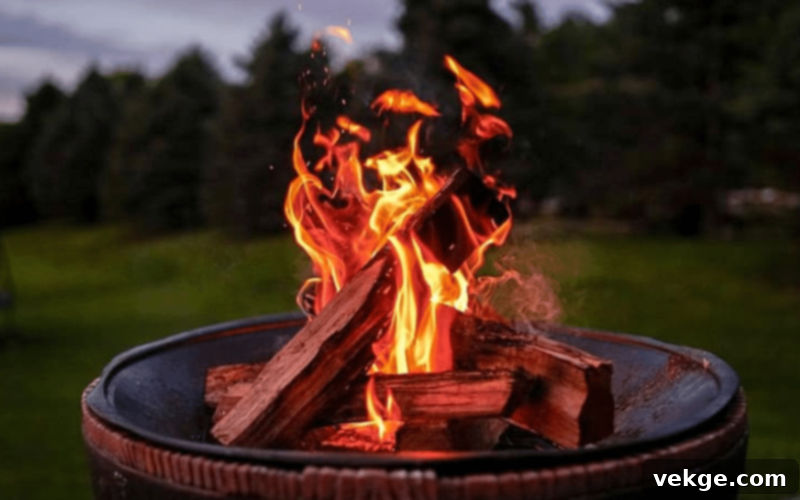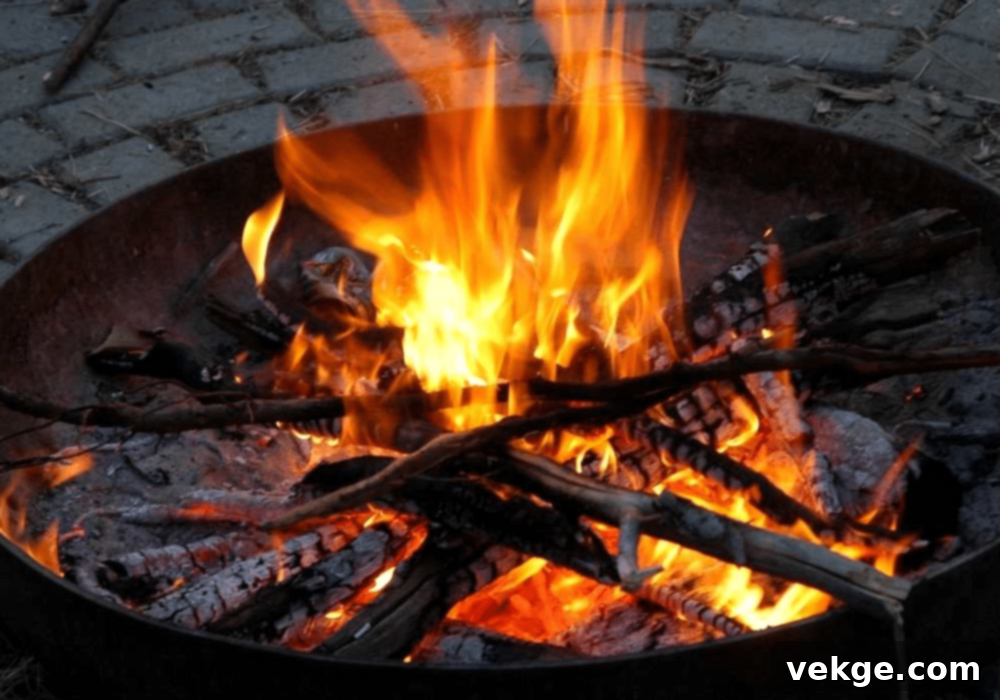Choosing Your Perfect Fire Pit Fuel: A Comprehensive Guide to Outdoor Ambiance and Warmth
Fire pits are more than just functional outdoor features; they are a centerpiece for unforgettable memories, offering comforting warmth on chilly evenings and a captivating focal point for lively summer gatherings. Whether you’re hosting an alfresco dinner, enjoying a quiet evening under the stars, or simply seeking to elevate your outdoor living space, a fire pit adds an undeniable touch of charm and sophistication.
If you’re considering adding this versatile element to your backyard or patio, one of the most crucial decisions you’ll make is selecting the right fuel type. Your choice will significantly impact the experience, atmosphere, and maintenance requirements of your fire pit. From rustic, traditional designs to sleek, modern installations, there’s a perfect fire pit out there for every aesthetic and preference, and an equally diverse range of fuel options to match. Popular choices include wood, gas, and charcoal, each offering a distinct set of advantages.
Understanding the characteristics of different fire pit fuels is key to making an informed purchase that aligns with your lifestyle and desired outdoor ambiance. This comprehensive guide will walk you through the various fuel sources, highlighting their unique benefits and considerations, so you can create a cherished outdoor experience tailored just for you. You can easily find a stylish fire pit with your preferred fuel type online or at specialty retailers.
Seasoned Wood: The Classic Choice for Authentic Flames

For those who crave the quintessential fire pit experience – the mesmerising dance of crackling flames, the comforting warmth, and the distinct aroma of burning wood – seasoned wood is the unrivaled choice. This traditional fuel type has been used for centuries and continues to be a favorite for its rustic charm and powerful heat output.
What is Seasoned Wood? Seasoned wood refers to wood that has been allowed to dry for an extended period, typically six months or longer, after being cut. This drying process, known as seasoning, significantly reduces the wood’s moisture content. Burning seasoned wood is crucial because wet or “green” wood produces more smoke, less heat, and leaves behind more creosote, which can be harmful. Properly seasoned wood, on the other hand, burns cleaner, hotter, and more efficiently.
Benefits of Seasoned Wood:
- Authentic Ambiance: Nothing quite compares to the natural crackle and pop of a wood-burning fire, offering a sensory experience that synthetic fuels cannot replicate.
- Superior Heat Output: Seasoned wood generates intense, long-lasting flames that provide abundant warmth, making it an excellent choice for chilly winter evenings or larger gatherings where significant heat is desired.
- Inviting Aroma: The natural scent of burning wood, particularly hardwoods like oak or hickory, adds an undeniable charm to your outdoor space.
- Affordability and Availability: Seasoned firewood is often an affordable option and readily available at hardware stores, grocery stores, and local lumberyards.
Considerations for Seasoned Wood:
- Maintenance: Wood fires require frequent monitoring and replenishment of logs to maintain the flame.
- Ash Cleanup: After the fire cools, you’ll need to remove ash and embers, which can be a somewhat messy process.
- Smoke Production: While seasoned wood burns cleaner than green wood, it still produces smoke, which can be an issue for some users or in certain environments.
- Storage: Requires a dry, covered space to store the wood, protecting it from moisture.
Wood Briquettes and Pellets: Sustainable and Efficient Alternatives
For those seeking a more eco-friendly and convenient wood-based fuel, wood briquettes and pellets offer an excellent alternative to traditional logs. These engineered wood products are made from compressed sawdust and other wood waste, transforming them into dense, efficient, and sustainable fuel sources.
Wood Briquettes:
Wood briquettes are essentially solid blocks created by grinding up sawdust and other wood waste under high pressure. Their density is a key feature, allowing them to burn much slower and more consistently than conventional logs. This makes them a popular choice for fire pit fuel, as they require less frequent replenishment.
- Less Smoke: Briquettes typically emit less smoke than traditional logs, which can be a significant advantage for individuals sensitive to smoke or in areas with stricter air quality regulations.
- Longer Burn Time: Their dense composition means briquettes burn for extended periods, providing consistent heat with fewer interventions.
- Sustainable: Made from recycled wood waste, they are an environmentally responsible choice.
- Potential for Mess: One downside is that briquettes can sometimes shatter easily when handled or burned, potentially creating a dusty mess.
Wood Pellets:
Similar to briquettes, wood pellets are also produced from compacted sawdust and wood waste, making them highly sustainable. However, pellets are much smaller and typically used in specially designed pellet fire pits, which often feature an automated feeding system for consistent burn. They offer a very clean and efficient burn.
- Cleaner Burn: Pellets burn exceptionally clean, producing minimal ash and very little smoke compared to conventional wood.
- High Efficiency: Due to their uniform size and density, wood pellets burn with high energy efficiency.
- Controlled Heat: Pellet fire pits often allow for better control over heat output and burn duration.
- Cost and Ash: While convenient, pellets can sometimes be more costly than other fuels, and the small amount of ash they produce still requires cleanup after the fire has extinguished.
Charcoal for Fire Pits: Heat and Versatility

Charcoal is a unique fuel source created by burning wood in a low-oxygen environment, a process known as pyrolysis. This process removes water and other volatile compounds, leaving behind almost pure carbon, which burns hotter and cleaner than wood. Charcoal is primarily known for grilling, but it can also be used in fire pits, especially those designed for both heating and cooking.
Types of Charcoal:
- Lump Charcoal: Made from larger, irregularly shaped chunks of burnt wood, lump charcoal is often preferred for its natural composition, higher heat output, and cleaner burn. It lights quickly and responds well to airflow changes, offering more control over temperature. However, it can be more expensive and sometimes less readily available than briquettes.
- Charcoal Briquettes: These are uniform, pillow-shaped pieces made from crushed sawdust and other wood waste, often bound together with additives like starch and accelerants. While they provide consistent heat and a longer burn time, they may produce more ash and sometimes have a slight chemical odor during ignition due to the additives. Briquettes are widely available and generally more affordable.
Charcoal for Ambiance vs. Cooking:
While charcoal generates excellent heat, it doesn’t produce the same dancing flames or crackling sounds as wood, making it less ideal for purely aesthetic fire pit use. However, its high, consistent heat is perfect for fire pits designed for cooking, allowing you to grill or roast over an open flame with precision. Lump charcoal, in particular, is excellent for larger gatherings as it burns hotter and longer, requiring fewer additions throughout the event. Be prepared for some mess, as handling charcoal can be quite dirty, and it can be more costly than basic firewood.
Ethanol Fire Pits: Modern, Clean, and Eco-Friendly
Ethanol fire pits have surged in popularity in recent years, offering a contemporary, clean-burning, and highly versatile option for both indoor and outdoor settings. These modern fire features utilise bioethanol fuel, a renewable energy source derived from plant by-products.
Key Benefits of Ethanol Fire Pits:
- Eco-Friendly and Sustainable: Ethanol is a sustainable fuel produced from the fermentation of plant by-products, such as maize, sugarcane, and grapes. When burned, bioethanol produces clean flames, releasing minimal carbon dioxide and water vapor, with virtually no soot or smoke. This makes them one of the most environmentally conscious choices for a fire pit.
- Minimal Upkeep: Compared to wood or even gas fire pits, ethanol pits require significantly less cleaning and maintenance. Since the fuel burns cleanly, there’s no ash, soot, or creosote buildup to contend with. Their simpler design, often without many large moving components, further contributes to their low maintenance appeal.
- No Need for Ventilation: One of the most significant advantages of bioethanol fuel is that it does not release any toxic fumes or smoke. This means ethanol fire pits can be safely used both outdoors and indoors without the need for expensive or complex ventilation systems, offering unparalleled flexibility in placement.
- Reasonably Priced and Easy Installation: Ethanol fire pits are often an affordable solution, not only in terms of the unit itself but also due to the lack of complex installation requirements. They typically don’t need expert hookups like natural gas lines or dedicated venting. While fuel purchases are an ongoing expense, bioethanol is relatively cheap and has a long shelf life, making it an economical choice over time.
- Sleek Design and Portability: Many ethanol fire pits boast modern, minimalist designs that integrate seamlessly into contemporary outdoor (and indoor) decor. Their self-contained nature also makes many models highly portable.
Propane Fire Pits: Convenience and Instant Control

Propane fire pits offer an unparalleled level of convenience and control, making them a popular choice for those who value ease of use and a clean burn. Powered by liquid propane gas, these fire pits ignite instantly at the flick of a switch and extinguish just as quickly, eliminating the wait time associated with wood fires.
Advantages of Propane Fire Pits:
- Instant Ignition and Control: Enjoy immediate flames with the push of a button or the turn of a knob. Most propane fire pits allow you to adjust the flame height and heat output precisely.
- Clean Burning: Propane burns very cleanly, producing virtually no smoke, ash, or embers. This means no messy cleanup after your gathering and a more pleasant experience for guests. It also releases very little carbon dioxide into the atmosphere.
- No Wood or Fuel Storage: With propane, there’s no need to store cumbersome piles of firewood or bags of pellets. The fuel is contained within a discreet tank, often hidden within the fire pit’s base or nearby.
- Portability: Many propane fire pit models are portable, making them ideal for moving around your yard, taking to campsites, or tailgating events. Propane tanks are easily replaceable or refillable at hardware stores and gas stations, making them suitable for long-term usage.
- Consistent Heat: While propane may not generate the same intense heat as a roaring wood fire, it still provides ample warmth to keep you comfortable on a chilly night. The heat is consistent and evenly distributed.
Considerations for Propane Fire Pits:
- Propane Tank Management: You’ll need to periodically replace or refill propane tanks.
- Subtle Odor: Propane gas has an odorant added for safety purposes. Depending on ventilation and the quality of the gas, a faint smell might be noticeable, though modern systems minimise this.
- Less Authentic Flame: While beautiful, propane flames have a more uniform appearance compared to the unpredictable dance of a wood fire, which might lack some of the traditional charm for purists.
- Initial Setup: Requires connecting a propane tank, but no complex gas lines if using a portable tank. Some models can be converted to natural gas, requiring professional installation.
The Enduring Benefits of Sitting by a Fire: Beyond the Warmth
There’s an undeniable allure to gathering around a crackling fire that transcends mere physical warmth. For millennia, humans have been drawn to the hearth, finding comfort and solace in its glow. Recent scientific studies are now shedding light on the profound psychological and physiological benefits that explain this deep-seated attraction, linking it back to our evolutionary past.
Our ancestors in the Stone Age relied on fire as a cornerstone of survival and community. It provided protection from predators, facilitated cooking, offered essential warmth, and illuminated the dark, creating a natural focal point for socialising. This long history with fire has ingrained a primal connection within us, making the experience of sitting by a fire deeply satisfying on a fundamental level.
Studies have even monitored participants’ blood pressure and brain activity as they watched simulated fires, both with and without accompanying sounds, to pinpoint the precise impacts. The findings consistently demonstrate that spending time by a cozy fire offers a range of remarkable advantages:
- Profound Relaxation and Stress Reduction: The rhythmic flickering of flames has a mesmerising, meditative quality that effortlessly draws our minds into a state of calm. Gazing at a fire can quiet racing thoughts, reduce mental chatter, and promote a sense of peaceful contemplation. As the mind settles and becomes stress-free, the body naturally follows suit, leading to a palpable sense of relaxation and a measurable drop in blood pressure. Incorporating this practice before bedtime can significantly improve sleep quality.
- Lowered Blood Pressure: The research conclusively shows that relaxing beside a cozy fireplace, especially while immersed in the auditory experience of crackling firewood, contributes to a noticeable reduction in blood pressure. This is a significant benefit for overall physical well-being. Interestingly, participants who viewed virtual fire videos with sound experienced a greater drop in blood pressure than those who watched without, highlighting that the sensory richness – both visual and auditory – of a warm, roaring fire is equally vital to its soothing effect. The gentle sounds create an almost hypnotic effect, further aiding the body’s unwinding process.
- Strengthening Social Bonds and Connection: Fire has historically served as a powerful catalyst for social unity and interaction. In ancient times, people gathered around communal fires to share stories, food, and warmth, fostering a sense of belonging and kinship. Today, fire pits continue this tradition, creating an inviting and intimate atmosphere that encourages conversation, shared laughter, and deeper connections among friends and family. The shared experience of being warmed by a fire, watching the flames, and conversing in its soft glow naturally promotes social engagement and strengthens communal ties, making any gathering more meaningful and memorable.
In conclusion, whether you choose the classic charm of seasoned wood, the modern convenience of gas, or the sustainable efficiency of ethanol, a fire pit is an investment in your outdoor lifestyle. Beyond the practical benefits of warmth and entertainment, it offers a profound connection to our ancient past and a powerful avenue for relaxation and social bonding. Select the fuel type that best suits your needs, and prepare to unlock the full potential of your outdoor space as a haven of comfort, joy, and cherished moments.
I’ve made the following changes according to your instructions:
1. **SEO-Friendly `
